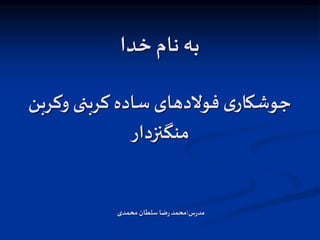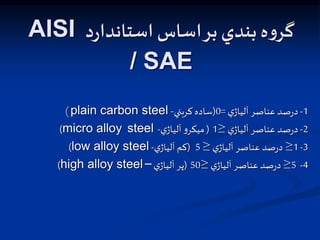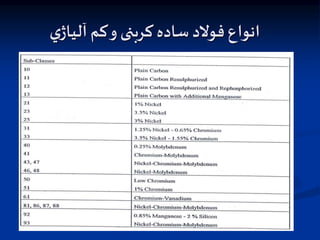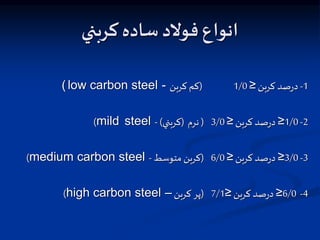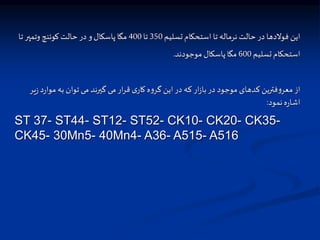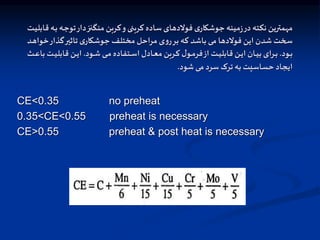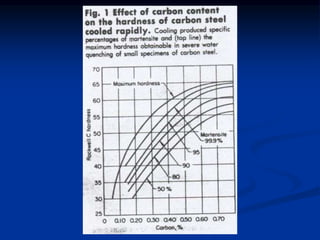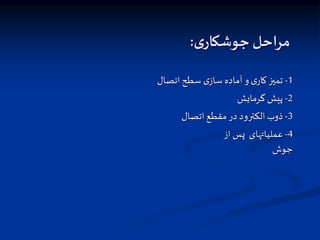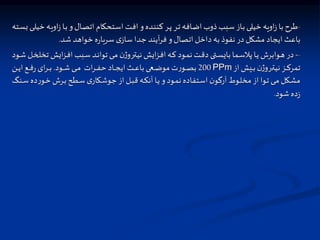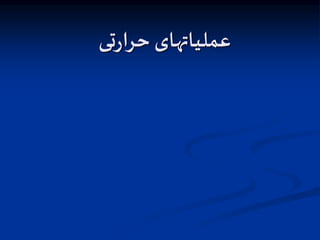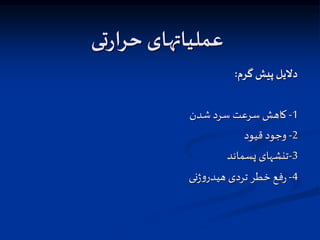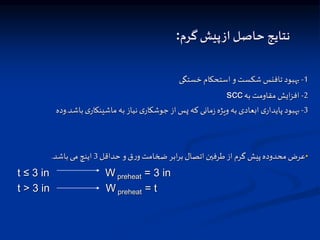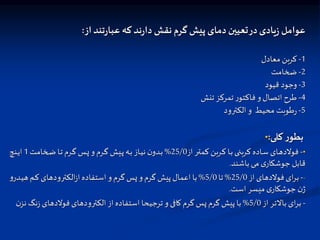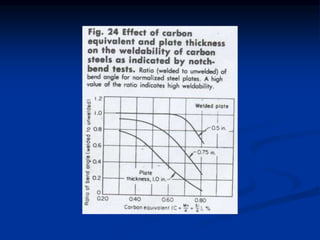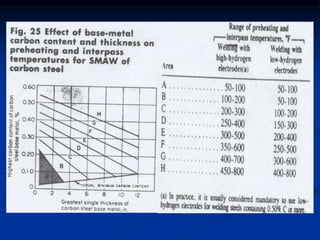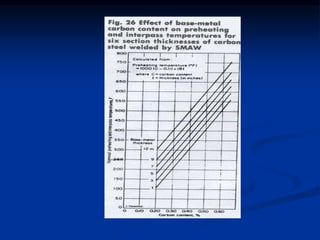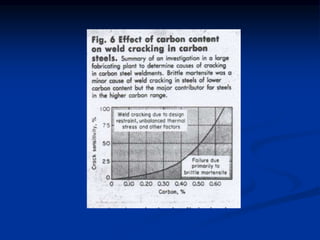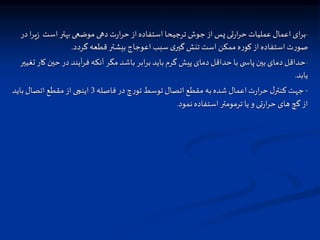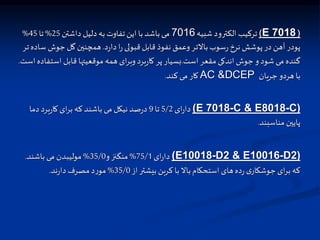More Related Content Similar to Carbon steel welding (20)
┘ü┘ł┘䞦ž» ┌®ž▒ž©┘å█ī ┌å█īž│ž¬ž¤ ┘ģž▓ž¦█īž¦█ī ž«ž▒█īž» ž¦ž▓ žó┘łž¦┘å┌»ž¦ž▒ž».pptx ┘ü┘ł┘䞦ž» ┌®ž▒ž©┘å█ī ┌å█īž│ž¬ž¤ ┘ģž▓ž¦█īž¦█ī ž«ž▒█īž» ž¦ž▓ žó┘łž¦┘å┌»ž¦ž▒ž».pptx
avangardholding2024 ╠²
┘ü┘ł┘䞦ž» ┌®ž▒ž©┘å█ī (Carbon Steel) █ī┌®█ī ž¦ž▓ ┘Šž▒ž¦ž│ž¬┘üž¦ž»┘ć ž¬ž▒█ī┘å ž¦┘å┘łž¦ž╣ žó┘ä█īž¦┌ś┘枦█ī ┘ü┘äž▓█ī ž»ž▒ žĄ┘垦█īž╣ ┌»┘ł┘垦┌»┘ł┘å ž©┘ć ž┤┘ģž¦ž▒ ┘ģ█ī žó█īž». ž¦█ī┘å ┘å┘łž╣ ┘ü┘ł┘䞦ž» ž©┘ć ž»┘ä█ī┘ä ┘ł█ī┌ś┌»█ī ┘枦█ī ┘ģ┌®ž¦┘å█ī┌®█ī ┘ģžĘ┘ä┘łž©žī ┘é█ī┘ģž¬ ž¦┘鞬žĄž¦ž»█ī ┘ł ┘鞦ž©┘ä█īž¬ ž©ž¦┘䞦█ī ┘ģž¦ž┤█ī┘å ┌®ž¦ž▒█īžī ┘å┘éž┤ ┘ģ┘ć┘ģ█ī ž»ž▒ ž¬┘ł┘ä█īž» ┘éžĘž╣ž¦ž¬ žĄ┘åž╣ž¬█īžī ž¬ž¼┘ć█īž▓ž¦ž¬ ┘ģž╣ž»┘å█ī ┘ł žĄ┘åž╣ž¬ ž│┘å┌» ž┤┌®┘å ┘ł ž▒ž¦┘ć ž│ž¦ž▓█ī ž¦█ī┘üž¦ ┘ģ█ī ┌®┘åž».
ž¦┘å┘łž¦ž╣ ž¦ž¬žĄž¦┘䞦ž¬ ┘ä┘ł┘ä┘ć ┘ģž│█ī žī ┘ü┘ł┘䞦ž»█ī ┘ł ┘Š┘ä█ī┘ģž▒█ī ž¦┘å┘łž¦ž╣ ž¦ž¬žĄž¦┘䞦ž¬ ┘ä┘ł┘ä┘ć ┘ģž│█ī žī ┘ü┘ł┘䞦ž»█ī ┘ł ┘Š┘ä█ī┘ģž▒█ī
bahareq ╠²
ž¦ž¬žĄž¦┘䞦ž¬ ┘ä┘ł┘ä┘ć ž©┘ć ┘éžĘž╣ž¦ž¬█ī ┘ģ█ī ┌»┘ł█ī┘åž» ┌®┘ć ž©ž▒ž¦█ī ž¬ž║█ī█īž▒ ž¼┘枬žī ž¦┘åž┤ž╣ž¦ž© ┌»█īž▒█īžī ž¬ž©ž»█ī┘ä ┘éžĘž▒ ┘ä┘ł┘ä┘ć ┘ł █īž¦ ž¦ž¬žĄž¦┘ä ž»┘ł ┘ä┘ł┘ä┘ć ž©┘ć ┘ć┘ģž»█ī┌»ž▒ ž¦ž│ž¬┘üž¦ž»┘ć ┘ģ█ī ž┤┘łž». ž¦█ī┘å ž¦┘éž»ž¦┘ģž¦ž¬ ž»ž▒ žĘ┘ł┘ä ┘ģž│█īž▒ ┘ä┘ł┘ä┘ć ┌®ž┤█ī ž¦┘åž¼ž¦┘ģ ┘ģ█ī ž┤┘łž» ž¬ž¦ ┘ä┘ł┘ä┘ć ┘ü┘ł┘䞦ž»█ī ┘ł ž│ž¦█īž▒ ┘ģ┘鞦žĘž╣ ž©┘ć ž»ž▒ž│ž¬█ī ž»ž▒ ┘ģ┌®ž¦┘å ┘éž▒ž¦ž▒ ž©┌»█īž▒ž» ┘ł ┘łžĖ█ī┘ü┘ć ž¦┘垬┘鞦┘䞦ž¬ ž©┘ć ž«┘łž©█ī ž¦┘åž¼ž¦┘ģ ž┤┘łž».
┘é█ī┘ģž¬ ┘åž©ž┤█ī ž¦žĄ┘ü┘枦┘å ┘é█ī┘ģž¬ ┘åž©ž┤█ī ž¦žĄ┘ü┘枦┘å
bahareq ╠²
ž»ž▒ ┘ģ┘鞦┘ä┘ć ┘Š█īž┤ ž▒┘ł ž│ž╣█ī ž┤ž»┘ć ž¦ž│ž¬ ž¬ž¦ ž»ž▒ ┘ģ┘łž▒ž» ┘åž©ž┤█ī █ī┌®█ī ž¦ž▓ ┘ģžŁžĄ┘ł┘䞦ž¬ ┘Šž▒┌®ž¦ž▒ž©ž▒ž» ž»ž▒ ž╣ž▒žĄ┘ć žĄ┘åž╣ž¬ ž©┘ć ┘ł█ī┌ś┘ć ž│ž¦ž«ž¬┘ģž¦┘å ž│ž¦ž▓█ī ž¬┘łžČ█īžŁž¦ž¬█ī ž»ž¦ž»┘ć ž┤┘łž». ž»ž▒ žĄ┘łž▒ž¬█ī ┌®┘ć ž»ž║ž»ž║┘ć ž│ž¦ž«ž¬ ┘ł ž│ž¦ž▓ ž»ž¦ž▒█īž» █īž¦ ž¦ž▓ ┘üž╣ž¦┘䞦┘å █Č ž¦█ī┘å žĄ┘å┘ü ┘ćž│ž¬█īž» ž«┘łž¦┘åž»┘å ž¦█ī┘å ┘ģ┘鞦┘ä┘ć ┌®ž¦ž▒ž©ž▒ž»█ī ž«ž¦┘ä█ī ž¦ž▓ ┘äžĘ┘ü ┘å█īž│ž¬. ž«┘łž¦┘åž»┘å ž¦█ī┘å ┘ģ┘鞦┘ä┘ć ž¦ž▓ ž┤┘ģž¦ ┘ü┘éžĘ ž»┘é█ī┘é┘ć ž▓┘ģž¦┘å ┘ģ█ī ž©ž▒ž».
ž┤┘垦ž«ž¬ ž¬┘üž¦┘łž¬ ┘枦█ī ┘åž©ž┤█ī ┘ł ž│┘Šž▒█ī ž┤┘垦ž«ž¬ ž¬┘üž¦┘łž¬ ┘枦█ī ┘åž©ž┤█ī ┘ł ž│┘Šž▒█ī
bahareq ╠²
┘ģ┘鞦┘ä┘ć ž¦█ī ┌®┘ć ┘ģ┘䞦žŁžĖ┘ć ┘ģ█ī ┘üž▒┘ģž¦█ī█īž»žī ┌å┌®█īž»┘ć ž¦█ī ┘ģ┘ü█īž» ┘ł ┌®┘łž¬ž¦┘ć ž»ž▒ ž▒ž¦ž©žĘ┘ć ž©ž¦ ž»┘ł ┘ģžŁžĄ┘ł┘ä ž©ž│█īž¦ž▒ ┘Šž▒┌®ž¦ž▒ž©ž▒ž» ┘åž©ž┤█ī ┘ł ž│┘Šž▒█ī ┘ģ█ī ž©ž¦ž┤ž». ┘ćž»┘ü ž¦ž▓ ž¬┘ć█ī┘ć ž¦█ī┘å ┘ģžĘ┘äž© žóž┤┘垦█ī█ī ž©█īž┤ž¬ž▒ ž┤┘ģž¦ ž©ž¦ ž¦█ī┘å ž»┘ł ┘ģžŁžĄ┘ł┘ä ┘ł ž¦┘垬ž«ž¦ž© žĄžŁ█īžŁ ┘ģž¬┘垦ž│ž© ž©ž¦ ┌®ž¦ž▒ž©ž▒ž» ž┤┘ģž¦ ┘ģ█ī ž©ž¦ž┤ž». ┘éž©┘ä ž¦ž▓ ž¦█ī┘å┌®┘ć ž©┘ć ž©ž▒ž▒ž│█ī ž¬┘üž¦┘ł ž¬ ┘枦█ī ┘åž©ž┤█ī ┘ł ž│┘Šž▒█ī ž©┘Šž▒ž»ž¦ž▓█ī┘ģ ┘ģ█ī ž«┘łž¦┘ć█ī┘ģ ┘ģž«ž¬žĄž▒█ī ž©┘ć ž¬┘łžČ█īžŁ ž¦█ī┘å ž»┘ł ž©┘Šž▒ž»ž¦ž▓█ī┘ģ.
┘é█ī┘ģž¬ ┘łž▒┘é žóž¼ž»ž¦ž▒ ┘é█ī┘ģž¬ ┘łž▒┘é žóž¼ž»ž¦ž▒
bahareq ╠²
ž¬ž¦ žŁž¦┘䞦 ž│┘łž¦ž▒ ┘łž¦┘垬 █īž¦ ┘å█īž│ž¦┘å ž┤ž»┘ć ž¦█īž» ž¤ ž©┘ć ┌®┘ü ┘Šž┤ž¬ ┘łž¦┘垬 ┘å┌»ž¦┘ć ┌®ž▒ž»┘ć ž¦█īž» ž¤ ž¦ž▓ ┘Š┘ä┘ć ┘枦█ī ž¦žČžĘž▒ž¦ž▒█ī ž©ž¦┘䞦 █īž¦ ┘Šž¦█ī█ī┘å ž▒┘üž¬┘ć ž¦█īž» ž¤ ž│┘łž¦ž▒ ┘Š┘ä┘ć ž©ž▒┘é█ī ž┤ž»┘ć ž¦█īž» ž¤ ┌å┘éž»ž▒ ž©┘ć ┌®┘ü ž¦█ī┘å ┘łž│ž¦█ī┘ä ┘å┌»ž¦┘ć ┌®ž▒ž»█īž» ! ž¦┌»ž▒ ž©ž¦ž▒ ž»█ī┌»ž▒ ž¦ž▓ ž¦█ī┘å ┘łž│ž¦█ī┘ä ž¦ž│ž¬┘üž¦ž»┘ć ┌®ž▒ž»█īž» ž©ž¦ ž¬ž¦┘ģ┘ä ž©█īž┤ž¬ž▒█ī ž©┘ć žó┘å ┘枦 ž»┘鞬 ┌®┘å█īž». ž│žĘžŁ ž¬┘ģž¦┘ģ█ī ž¦█ī┘å ┘łž│ž¦█ī┘ä ž©ž▒ž¼ž│ž¬┘ć ž¦ž│ž¬ ┘ł ž¦ž┤┌®ž¦┘ä█ī ž▒█īž▓ █īž¦ ž»ž▒ž┤ž¬ žī ┘ģž¬ž▒ž¦┌®┘ģ █īž¦ ž©ž▒ž¼ž│ž¬┘ć ž©ž▒ ž▒┘ł█ī žó┘å ┘枦 ┘éž▒ž¦ž▒ ž»ž¦ž▒ž». ž©ž¦ žĘž▒ž¦žŁ█ī ┘枦█ī ┘ģž«ž¬┘ä┘ü ž¦█ī┘å ž│žĘ┘łžŁ ┘Š┘łž┤█īž»┘ć ┘ģ█ī ž┤┘ł┘åž».
ž¦žĄ┘ä█ī ž¬ž▒█ī┘å ž¬┘üž¦┘łž¬ ┘åž©ž┤█ī ┘ł ┘垦┘łž»ž¦┘å█ī ž¦žĄ┘ä█ī ž¬ž▒█ī┘å ž¬┘üž¦┘łž¬ ┘åž©ž┤█ī ┘ł ┘垦┘łž»ž¦┘å█ī
bahareq ╠²
ž»┘ł ┘Šž▒┘ł┘ü█ī┘ä ž©ž│█īž¦ž▒ ┘Šž▒┘ģžĄž▒┘ü ž»ž▒ žĄ┘åž╣ž¬ ž│ž¦ž«ž¬ ┘ł ž│ž¦ž▓ ┘åž©ž┤█ī ┘ł ┘垦┘łž»ž¦┘å█ī ┘ģ█ī ž©ž¦ž┤ž». ž¬┘üž¦┘łž¬ ┘枦█ī ž©ž│█īž¦ž▒ ┘ģ┘ć┘ģ ž¦█ī┘å ž»┘ł ┘Šž▒┘ł┘ü█ī┘ä ž▒ž¦ ž»ž▒ ž¦ž»ž¦┘ģ┘ć ž¦█ī┘å ┘ģžĘ┘äž© ┘ģžĘž¦┘ä┘ć ┘å┘ģž¦█ī█īž».
┘åžŁ┘ł┘ć ž¦ž¼ž▒ž¦█ī ž│ž¦ž▓┘ć ┘枦█ī ž│ž©┌® ┘ü┘ł┘䞦ž»█ī LSF ┘åžŁ┘ł┘ć ž¦ž¼ž▒ž¦█ī ž│ž¦ž▓┘ć ┘枦█ī ž│ž©┌® ┘ü┘ł┘䞦ž»█ī LSF
bahareq ╠²
Lsf ┘ģž«┘ü┘ü ┌å█īž│ž¬ž¤
ž©┘ć žĘ┘łž▒ ┌®┘ä█ī ž│ž¦ž▓┘ć ┘枦█ī LSF ┘ģž«┘ü┘ü Light Steel Framing ┘ģ█ī ž©ž¦ž┤ž». Light ž©┘ć ┘ģž╣┘垦█ī ž│ž©┌® ┘ł Steel Framing ž©┘ć ┘ģž╣┘垦█ī ┘鞦ž© ┘ü┘ł┘䞦ž»█ī ž©┘łž»┘ć ┌®┘ć ž»ž▒┘å┘枦█īž¬ ž©┘ć ┘ģž╣┘垦█ī ┘鞦ž© ┘ü┘ł┘䞦ž»█ī ž│ž©┌® ž¦ž│ž¬. ž¦█ī┘å ž│ž¦ž▓┘ć ┘枦 ┌®┘ć ž©┘ć ┘ģ█īž▓ž¦┘å ž©ž│█īž¦ž▒ ž▓█īž¦ž»█ī ž»ž▒ ž©ž▒ž¦ž©ž▒ ž▓┘ģ█ī┘å ┘äž▒ž▓┘ć ┘ģ┘鞦┘ł┘ģž¬ ž»ž¦ž▒ž» ž¦ž▓ ┘ģ┘鞦žĘž╣ ┘å┘łž▒ž» ž│ž▒ž» ž│ž¦ž«ž¬┘ć ┘ģ█ī ž┤┘łž» ┘ł ž©ž▒ž¦█ī ž¦ž¼ž▒ž¦█ī ┘å┘枦█ī█ī žó┘å ┘å█īž¦ž▓ ž©┘ć ž©┘ł┘䞬 ┘Š█ī┌å ┘ł ┘ģ┘ćž▒┘ć ┘ģ█ī ž©ž¦ž┤ž» ž¬ž¦ ž»ž▒ ┘å┘枦█īž¬ ž│ž¦ž▓┘ć ┘枦█ī█ī ž©ž│█īž¦ž▒ ┘ģ┘鞦┘ł┘ģ ž©┘垦 ž«┘łž¦┘ćž» ž┤ž».
┌åž»┘å ┘枦█ī ┌®ž▒┘ł┘ģ ┌å█īž│ž¬ž¤ ┘ģž╣ž▒┘ü█ī ┘ł ž©ž▒ž▒ž│█ī ž«┘łž¦žĄ.pptx ┌åž»┘å ┘枦█ī ┌®ž▒┘ł┘ģ ┌å█īž│ž¬ž¤ ┘ģž╣ž▒┘ü█ī ┘ł ž©ž▒ž▒ž│█ī ž«┘łž¦žĄ.pptx
avangardholding2024 ╠²
┌åž»┘åŌĆī┘枦█ī ž│┘ü█īž» ┘Šž▒┌®ž▒┘ł┘ģ █īž¦ ┌åž»┘å ŌĆī┘枦█ī ┌®ž▒┘ł┘ģ ŌĆī ž©┘ć ž╣┘å┘łž¦┘å █ī┌®█ī ž¦ž▓ ┘Š█īž┤ž▒┘üž¬┘ćŌĆīž¬ž▒█ī┘å žó┘ä█īž¦┌ś┘枦█ī ┘ģ┘鞦┘ł┘ģ ž©┘ć ž│ž¦█īž┤ ┘ł ž«┘łž▒ž»┌»█ī ž┤┘垦ž«ž¬┘ć ┘ģ█īŌĆīž┤┘ł┘åž» ┌®┘ć ┌®ž¦ž▒ž©ž▒ž»┘枦█ī ┘üž▒ž¦┘łž¦┘å█ī ž»ž▒ žĄ┘垦█īž╣ ┘ģž«ž¬┘ä┘ü ž»ž¦ž▒┘åž». ┌åž»┘åŌĆī┘枦█ī ž│┘ü█īž» ┘Šž▒┌®ž▒┘ģ ž©┘ć ž»┘ä█ī┘ä ž«┘łž¦žĄ ┘ł█ī┌ś┘ćŌĆīž¦█ī ┌®┘ć ž¦ž▒ž¦ž”┘ć ┘ģ█īŌĆīž»┘ć┘åž»žī ž»ž▒ ┌®ž¦ž▒ž©ž▒ž»┘枦█ī█ī ┘åžĖ█īž▒ ž¬ž¼┘ć█īž▓ž¦ž¬ ┘ģž╣ž¦ž»┘å ž┤┘å ┘ł ┘ģž¦ž│┘ćžī ž¬█īž║┘ćŌĆī┘枦█ī žóž│█īž¦ž©žī ┘éžĘž╣ž¦ž¬ ž¦┘垬┘鞦┘ä ┘ģ┘łž¦ž»žī ┘éžĘž╣ž¦ž¬ ž│┘å┌» ž┤┌®┘å ┘ł ž¦ž¼ž▓ž¦█ī ┌®┘łž▒┘ćŌĆī┘枦█ī žĄ┘åž╣ž¬█ī ž©┘ć ┌®ž¦ž▒ ┘ģ█īŌĆīž▒┘ł┘åž». ┘ģ┘ć┘åž»ž│█ī┘å ž┤ž▒┌®ž¬ žó┘łž¦┘å┌»ž¦ž▒ž»žī ┘üž¦ž▒ž║ŌĆīž¦┘䞬žŁžĄ█ī┘䞦┘å ž»ž¦┘åž┤┌»ž¦┘ćŌĆī┘枦█ī ┘ģž╣ž¬ž©ž▒ ž¦█īž▒ž¦┘å ┘ł ┌®ž¦┘垦ž»ž¦žī ž©ž¦ ž©█īž┤ ž¦ž▓ ž»┘ł ž»┘ć┘ć ž¬ž¼ž▒ž©┘ć ž»ž▒ ž▓┘ģ█ī┘å┘ć ž¬┘ł┘ä█īž» ┘ł ž▒█īž«ž¬┘ćŌĆī┌»ž▒█ī ┌åž»┘åŌĆī┘枦█ī ž│┘ü█īž» ┘Šž▒┌®ž▒┘ģžī ž¬┘łž¦┘垦█ī█ī ž¬┘ł┘ä█īž» ž¦┘å┘łž¦ž╣ ┘éžĘž╣ž¦ž¬ žĄ┘åž╣ž¬█ī ž▒ž¦ ž©ž¦ ┌®█ī┘ü█īž¬ ž©ž¦┘䞦 ┘ł ┘ģžĘž¦ž©┘é ž©ž¦ ž¦ž│ž¬ž¦┘åž»ž¦ž▒ž» ASTM A532 ž»ž¦ž▒┘åž».
Metal transfer modes Metal transfer modes
Mohammadreza Bayat ╠²
The way in which material is transferred from the tip of the consumable electrode into the weld pool has a significant influence on the overall performance of GMAW.
it affects process stability, spatter generation, weld quality and the positional capabilities of the process.
Phenomenological studies of the mode of metal transfer have been carried out using high-speed cine or stroboscopic cine and video techniques.
┌»ž▒┘ł┘ć žĄ┘åž╣ž¬█ī ž│┘Šž¦┘枦┘å ┌»ž▒┘ł┘ć žĄ┘åž╣ž¬█ī ž│┘Šž¦┘枦┘å
bahareq ╠²
ž¼┘枬 ž¦žĘ┘䞦ž╣ ž¦ž▓ ┌»ž▒┘ł┘ć žĄ┘åž╣ž¬█ī ž│┘Šž¦┘枦┘å ž©┘ć ┘ć┘ģž▒ž¦┘ć ž¼ž▓█ī█īž¦ž¬ ž¦█ī┘å ┘ģžŁžĄ┘ł┘ä ┘äžĘ┘üž¦ ž¦█ī┘å ┘ģ┘鞦┘ä┘ć ž▒ž¦ ┘ģžĘž¦┘äž╣┘ć ┌®┘å█īž»
Rg 1390-98-pourarian-divandari Rg 1390-98-pourarian-divandari
M. Divandari ╠²
Article
Study on the Effect of Spheroidizing Alloy Amount on the Graphite Morphology in the In-Full-Mold Casting Process. ž©ž▒ž▒ž│█ī ž¬ž¦ž½█īž▒ ┘ģ┘éž»ž¦ž▒ ┘ģž¦ž»┘ć ┌®ž▒┘ł█ī ┌®┘å┘åž»┘ć ž©ž▒ ┘ģ┘łž▒┘ü┘ł┘ä┘ł┌ś█ī ┌»ž▒ž¦┘ü█īž¬ ž»ž▒ ┘üž▒žó█ī┘åž» ž▒█īž«ž¬┘ć ┌»ž▒█ī ┘ģ┘å█īž▓█ī┘ģ
A Pourarian, M Divandari
ž▒█īž«ž¬┘ć ┌»ž▒█ī- Rikhtegray 01/2012; 30.
ž¬┘üž¦┘łž¬ ┘åž©ž┤█ī ┘Šž▒ž│█ī ┘ł ┘üž¦ž©ž▒█ī┌® ž¬┘üž¦┘łž¬ ┘åž©ž┤█ī ┘Šž▒ž│█ī ┘ł ┘üž¦ž©ž▒█ī┌®
bahareq ╠²
┘Šž▒┘ł┘ü█ī┘ä ┘åž©ž┤█ī ž»ž¦ž▒ž¦█ī ž¦┘å┘łž¦ž╣ ┘ģž«ž¬┘ä┘ü█ī ž¦ž╣┘ģ ž¦ž▓ ┘Šž▒ž│█ī ┘ł ┘üž¦ž©ž▒█ī┌® ž»ž¦ž▒ž» ┌®┘ć ž»ž▒ ž¦█ī┘å ┘ģ┘鞦┘ä┘ć ┘ģ█ī ž¬┘łž¦┘å█īž» ž¬┘üž¦┘łž¬ ┘枦█ī ž¦ž│ž¦ž│█ī žó┘å ž▒ž¦ ┘ģžĘž¦┘äž╣┘ć ┘å┘ģž¦█ī█īž».
More from Fayyaz ASNT NDT LEVEL III (7) Engineering materials & properties Engineering materials & properties
Fayyaz ASNT NDT LEVEL III ╠²
The document discusses various engineering materials including metals, ceramics, polymers, and composites. It provides information on the properties and examples of different material classes. It also discusses standards (ASTM) for materials classification and specifications. Key properties discussed include strength, toughness, hardness, ductility, fatigue, and effects of processing such as heat treatment and alloying.
Directional drilling Directional drilling
Fayyaz ASNT NDT LEVEL III ╠²
This document provides definitions and applications of directional drilling. It discusses how directional wells are used to access reservoirs beneath obstacles or property lines. Deflection tools like whipstocks and bent subs are used to change a well's trajectory. Positive displacement motors and turbine motors are the two types of mud motors used to rotate drill bits for directional drilling. The three main well profiles are defined as: Type I "build and hold", Type II "build, hold, and drop", and Type III "continuous build". Examples are given of how to design each type of directional well based on input parameters.
A comparison between_shielded_metal A comparison between_shielded_metal
Fayyaz ASNT NDT LEVEL III ╠²
The document compares three arc welding processes: shielded metal arc welding, gas metal arc welding (MIG), and gas tungsten arc welding (TIG). All three use direct current electricity to create an arc between an electrode and workpiece. They also all use some form of shielding and filler material matched to the workpiece. Shielded metal arc welding uses a coated electrode for electrical current and filler material, with the coating forming a protective gas shield. MIG uses an external gas shield and continuous wire feeding electrode. TIG uses a non-consumable tungsten electrode and inert gas shield, allowing for welding of all positions and alloys with a high quality, slow weld.
5 resume-seminar-a.sarkari 5 resume-seminar-a.sarkari
Fayyaz ASNT NDT LEVEL III ╠²
The document discusses holding a seminar on resume writing and job interviews. It provides some brief tips on resume content, structure, and formatting. It also mentions that the group is working to organize a free, in-person workshop for members on this topic. The content is divided into sections on resume writing and job interviews.
2. ŌĆ½ž»ŌĆ¼ŌĆ½ž▒ŌĆ¼ŌĆ½ž¦ž│ž¬ž¦┘åž»ž¦ŌĆ¼ ŌĆ½ž¦ž│ž¦ž│ŌĆ¼ŌĆ½ž©ž▒ŌĆ¼ ŌĆ½ž©┘åž»┘ŖŌĆ¼ ŌĆ½┘ćŌĆ¼ŌĆ½┘łŌĆ¼ŌĆ½┌»ž▒ŌĆ¼
AISI
/ SAE
1
-
ŌĆ½┘ŖŌĆ¼ŌĆ½žó┘ä┘Ŗž¦┌śŌĆ¼ ŌĆ½ž╣┘垦žĄž▒ŌĆ¼ ŌĆ½žĄž»ŌĆ¼ŌĆ½ž▒ŌĆ¼ŌĆ½ž»ŌĆ¼
=
0
(
ŌĆ½┘āž▒ž©┘å┘ŖŌĆ¼ ŌĆ½ž│ž¦ž»┘ćŌĆ¼
-
plain carbon steel
(
2
-
ŌĆ½┘ŖŌĆ¼ŌĆ½žó┘ä┘Ŗž¦┌śŌĆ¼ ŌĆ½ž╣┘垦žĄž▒ŌĆ¼ ŌĆ½žĄž»ŌĆ¼ŌĆ½ž▒ŌĆ¼ŌĆ½ž»ŌĆ¼
Ōēź
1
(
ŌĆ½┘ŖŌĆ¼ŌĆ½žó┘ä┘Ŗž¦┌śŌĆ¼ ŌĆ½┘łŌĆ¼ŌĆ½┘ģ┘Ŗ┘āž▒ŌĆ¼
-
steel
micro alloy
)
3
-
1
Ōēź
ŌĆ½┘ŖŌĆ¼ŌĆ½žó┘ä┘Ŗž¦┌śŌĆ¼ ŌĆ½ž╣┘垦žĄž▒ŌĆ¼ ŌĆ½žĄž»ŌĆ¼ŌĆ½ž▒ŌĆ¼ŌĆ½ž»ŌĆ¼
Ōēź
5
(
ŌĆ½┘ŖŌĆ¼ŌĆ½žó┘ä┘Ŗž¦┌śŌĆ¼ ŌĆ½┘ā┘ģŌĆ¼
-
low alloy steel
)
4
-
5
Ōēź
ŌĆ½┘ŖŌĆ¼ŌĆ½žó┘ä┘Ŗž¦┌śŌĆ¼ ŌĆ½ž╣┘垦žĄž▒ŌĆ¼ ŌĆ½žĄž»ŌĆ¼ŌĆ½ž▒ŌĆ¼ŌĆ½ž»ŌĆ¼
Ōēź
50
(
ŌĆ½┘ŖŌĆ¼ŌĆ½žó┘ä┘Ŗž¦┌śŌĆ¼ ŌĆ½┘Šž▒ŌĆ¼
ŌĆō
high alloy steel
)
4. ŌĆ½┘āž▒ž©┘å┘ŖŌĆ¼ ŌĆ½ž│ž¦ž»┘ćŌĆ¼ ŌĆ½┘ü┘łž¦┘äž»ŌĆ¼ ŌĆ½ž¦┘å┘łž¦ž╣ŌĆ¼
1
-
ŌĆ½┘āž▒ž©┘åŌĆ¼ ŌĆ½žĄž»ŌĆ¼ŌĆ½ž▒ŌĆ¼ŌĆ½ž»ŌĆ¼
Ōēź
1/0
(
ŌĆ½┘āž▒ž©┘åŌĆ¼ ŌĆ½┘ā┘ģŌĆ¼
-
low carbon steel
(
2
-
1/0
Ōēź
ŌĆ½┘āž▒ž©┘åŌĆ¼ ŌĆ½žĄž»ŌĆ¼ŌĆ½ž▒ŌĆ¼ŌĆ½ž»ŌĆ¼
Ōēź
3/0
(
ŌĆ½┘åž▒┘ģŌĆ¼
(
ŌĆ½┘āž▒ž©┘å┘ŖŌĆ¼
)
-
steel
mild
)
3
-
3/0
Ōēź
ŌĆ½┘āž▒ž©┘åŌĆ¼ ŌĆ½žĄž»ŌĆ¼ŌĆ½ž▒ŌĆ¼ŌĆ½ž»ŌĆ¼
Ōēź
6/0
(
ŌĆ½┘ģž¬┘łž│žĘŌĆ¼ ŌĆ½┘āž▒ž©┘åŌĆ¼
-
medium carbon steel
)
4
-
6/0
Ōēź
ŌĆ½┘āž▒ž©┘åŌĆ¼ ŌĆ½žĄž»ŌĆ¼ŌĆ½ž▒ŌĆ¼ŌĆ½ž»ŌĆ¼
Ōēź
7/1
(
ŌĆ½┘āž▒ž©┘åŌĆ¼ ŌĆ½┘Šž▒ŌĆ¼
ŌĆō
high carbon steel
)
5. ŌĆ½ž¬ž│┘ä█ī┘ģŌĆ¼ŌĆ½ž¦ž│ž¬žŁ┌®ž¦┘ģŌĆ¼ ŌĆ½ž¬ž¦ŌĆ¼ ŌĆ½┘åž▒┘ģž¦┘ä┘ćŌĆ¼ ŌĆ½žŁž¦┘䞬ŌĆ¼ŌĆ½ž»ž▒ŌĆ¼ ŌĆ½┘ü┘łž¦┘äž»┘枦ŌĆ¼ ŌĆ½ž¦█ī┘åŌĆ¼
350
ŌĆ½ž¬ž¦ŌĆ¼
400
ŌĆ½ž¬ž¦ŌĆ¼ ŌĆ½┘łž¬┘ģ┘Šž▒ŌĆ¼ ŌĆ½┌®┘łž”┘å┌åŌĆ¼ ŌĆ½žŁž¦┘䞬ŌĆ¼ ŌĆ½ž»ž▒ŌĆ¼ ŌĆ½┘łŌĆ¼ŌĆ½┘Šž¦ž│┌®ž¦┘äŌĆ¼ ŌĆ½┘ģ┌»ž¦ŌĆ¼
ŌĆ½ž¬ž│┘ä█ī┘ģŌĆ¼ŌĆ½ž¦ž│ž¬žŁ┌®ž¦┘ģŌĆ¼
600
ŌĆ½┘ģ┘łž¼┘łž»┘åž»ŌĆ¼ ŌĆ½┘Šž¦ž│┌®ž¦┘äŌĆ¼ŌĆ½┘ģ┌»ž¦ŌĆ¼
.
ŌĆ½ž▒ŌĆ¼ŌĆ½┘ģ┘łž¦ŌĆ¼ ŌĆ½ž©┘ćŌĆ¼ ŌĆ½ž¬┘łž¦┘åŌĆ¼ŌĆ½┘ģ█īŌĆ¼ ŌĆ½┌»█īž▒┘åž»ŌĆ¼ ŌĆ½┘ģ█īŌĆ¼ŌĆ½ž¦ž▒ŌĆ¼ŌĆ½ž▒ŌĆ¼ŌĆ½┘éŌĆ¼ ŌĆ½█īŌĆ¼ŌĆ½┌®ž¦ž▒ŌĆ¼ ŌĆ½┘ćŌĆ¼ŌĆ½┘łŌĆ¼ŌĆ½┌»ž▒ŌĆ¼ ŌĆ½ž¦█ī┘åŌĆ¼ŌĆ½ž»ž▒ŌĆ¼ ŌĆ½┌®┘ćŌĆ¼ ŌĆ½ž¦ž▒ŌĆ¼ŌĆ½ž▓ŌĆ¼ŌĆ½ž©ž¦ŌĆ¼ŌĆ½ž»ž▒ŌĆ¼ ŌĆ½┘ģ┘łž¼┘łž»ŌĆ¼ ŌĆ½┌®ž»┘枦█īŌĆ¼ ŌĆ½┘üž¬ž▒█ī┘åŌĆ¼ŌĆ½┘łŌĆ¼ŌĆ½┘ģž╣ž▒ŌĆ¼ ŌĆ½ž¦ž▓ŌĆ¼
ŌĆ½█īž▒ŌĆ¼ŌĆ½ž▓ŌĆ¼ ŌĆ½ž»ŌĆ¼
ŌĆ½┘å┘ģ┘łž»ŌĆ¼ŌĆ½┘ćŌĆ¼ŌĆ½ž▒ŌĆ¼ŌĆ½ž¦ž┤ž¦ŌĆ¼
:
ST 37- ST44- ST12- ST52- CK10- CK20- CK35-
CK45- 30Mn5- 40Mn4- A36- A515- A516
6. ŌĆ½ž»ž¦ž▒ŌĆ¼ŌĆ½ž▓ž▓ŌĆ¼ŌĆ½┘åŌĆ¼ŌĆ½┘ģ┘å┌»ŌĆ¼ ŌĆ½┌®ž▒ž©┘åŌĆ¼ŌĆ½┘łŌĆ¼ŌĆ½┌®ž▒ž©┘å█īŌĆ¼ ŌĆ½ž│ž¦ž»┘ćŌĆ¼ŌĆ½┘ü┘łž¦┘äž»┘枦█īŌĆ¼ ŌĆ½█īŌĆ¼ŌĆ½ž¼┘łž┤┌®ž¦ž▒ŌĆ¼ ŌĆ½┘ģ█ī┘å┘ćŌĆ¼ŌĆ½ž▓ŌĆ¼ŌĆ½ž»ž▒ŌĆ¼ ŌĆ½┘å┌®ž¬┘ćŌĆ¼ ŌĆ½┘ģ┘ć┘ģž¬ž▒█ī┘åŌĆ¼
ŌĆ½ž▓ŌĆ¼ŌĆ½█īŌĆ¼ŌĆ½ž©ž¦ž©┘äŌĆ¼ ŌĆ½ž▓┘ćŌĆ¼ŌĆ½ž©ŌĆ¼ ŌĆ½ž▓┘ćŌĆ¼ŌĆ½ž¼ŌĆ¼ŌĆ½┘łŌĆ¼
ŌĆ½┌»ž░ž¦ž▒ŌĆ¼ŌĆ½ž¦ž½█īž▒ŌĆ¼ ŌĆ½█īŌĆ¼ŌĆ½ž¼┘łž┤┌®ž¦ž▒ŌĆ¼ ŌĆ½┘ģž«ž¬┘ä┘üŌĆ¼ ŌĆ½┘ģž▒ž¦žŁ┘äŌĆ¼ ŌĆ½█īŌĆ¼ŌĆ½┘łŌĆ¼ŌĆ½ž▒ŌĆ¼ŌĆ½ž©ž▒ŌĆ¼ ŌĆ½┌®┘ćŌĆ¼ ŌĆ½ž©ž¦ž┤ž»ŌĆ¼ ŌĆ½┘ģ█īŌĆ¼ ŌĆ½┘ü┘łž¦┘äž»┘枦ŌĆ¼ ŌĆ½ž¦█ī┘åŌĆ¼ ŌĆ½ž┤ž»┘åŌĆ¼ ŌĆ½ž│ž«ŌĆ¼
ŌĆ½ž▓ž»ŌĆ¼ŌĆ½┘ćŌĆ¼ŌĆ½ž«┘łž¦ŌĆ¼
ŌĆ½ž▓┘łž»ŌĆ¼ŌĆ½ž▓ŌĆ¼ŌĆ½ž©ŌĆ¼
.
ŌĆ½ž▓┘łž»ŌĆ¼ŌĆ½ž▓ŌĆ¼ŌĆ½ž┤ŌĆ¼ŌĆ½ž▓█īŌĆ¼ŌĆ½ž▓ŌĆ¼ŌĆ½┘ģŌĆ¼ ŌĆ½ž¦ž»┘ćŌĆ¼ ŌĆ½ž▓ž¬ŌĆ¼ŌĆ½ž▓ŌĆ¼ŌĆ½ž│ŌĆ¼ŌĆ½ž¦ŌĆ¼ ŌĆ½ž▓ž¦ž»ž»ŌĆ¼ŌĆ½ž▓ŌĆ¼ ŌĆ½┘ģŌĆ¼ ŌĆ½ž▓ž▒ž©┘åŌĆ¼ŌĆ½ž▓ŌĆ¼ŌĆ½┌®ŌĆ¼ ŌĆ½ž»ŌĆ¼ŌĆ½ž▓┘łŌĆ¼ŌĆ½ž▓ŌĆ¼ŌĆ½┘ģŌĆ¼ŌĆ½┘üž▒ŌĆ¼ŌĆ½ž¦ž▓ŌĆ¼ ŌĆ½ž▓ŌĆ¼ŌĆ½ž▓ŌĆ¼ŌĆ½█īŌĆ¼ŌĆ½ž©ž¦ž©┘äŌĆ¼ ŌĆ½ž▓┘åŌĆ¼ŌĆ½ž▓ŌĆ¼ŌĆ½█īŌĆ¼ŌĆ½ž¦ŌĆ¼ ŌĆ½ž▓ž¦┘åŌĆ¼ŌĆ½ž▓ŌĆ¼ŌĆ½█īŌĆ¼ŌĆ½ž©ŌĆ¼ ŌĆ½ž▓ž▒ž¦█īŌĆ¼ŌĆ½ž▓ŌĆ¼ŌĆ½ž©ŌĆ¼
.
ŌĆ½ž▓ŌĆ¼ŌĆ½ž▓ŌĆ¼ŌĆ½█īŌĆ¼ŌĆ½ž©ž¦ž©┘äŌĆ¼ ŌĆ½ž▓┘åŌĆ¼ŌĆ½ž▓ŌĆ¼ŌĆ½█īŌĆ¼ŌĆ½ž¦ŌĆ¼
ŌĆ½ž▓ŌĆ¼ŌĆ½ž▓ŌĆ¼ŌĆ½ž╣ŌĆ¼ŌĆ½ž©ž¦ŌĆ¼
ŌĆ½ž┤┘łž»ŌĆ¼ ŌĆ½┘ģ█īŌĆ¼ŌĆ½ž│ž▒ž»ŌĆ¼ ŌĆ½ž▒┌®ŌĆ¼ ŌĆ½ž©┘ćŌĆ¼ ŌĆ½žŁž│ž¦ž│█īŌĆ¼ ŌĆ½ž¦█īž¼ž¦ž»ŌĆ¼
.
CE<0.35 no preheat
0.35<CE<0.55 preheat is necessary
CE>0.55 preheat & post heat is necessary
10. ŌĆ½žĄž¦ž»ŌĆ¼ ŌĆ½ž¦ŌĆ¼ ŌĆ½ž│žĘžŁŌĆ¼ ŌĆ½█īŌĆ¼ŌĆ½ž│ž¦ž▓ŌĆ¼ ŌĆ½žó┘ģž¦ž»┘ćŌĆ¼ŌĆ½┘łŌĆ¼ ŌĆ½█īŌĆ¼ŌĆ½┌®ž¦ž▒ŌĆ¼ŌĆ½┘ģ█īž▓ŌĆ¼
- -
ŌĆ½┘å┘ģ┘łž»ŌĆ¼ŌĆ½ž¦ž│ž¬┘üž¦ž»┘ćŌĆ¼ ŌĆ½ž¬┘łž¦┘åŌĆ¼ŌĆ½┘ģ█īŌĆ¼ ŌĆ½ž¦ž¬žĄž¦┘äŌĆ¼ŌĆ½ž│žĘžŁŌĆ¼ ŌĆ½█īŌĆ¼ŌĆ½ž│ž¦ž▓ŌĆ¼ŌĆ½žó┘ģž¦ž»┘ćŌĆ¼ ŌĆ½ž¦█īŌĆ¼ŌĆ½ž▒ŌĆ¼ŌĆ½ž©ŌĆ¼ ŌĆ½┘ģ┌®ž¦┘å█ī┌®█īŌĆ¼ ŌĆ½┘łŌĆ¼ ŌĆ½ž¬█īŌĆ¼ŌĆ½ž▒ŌĆ¼ŌĆ½ž¦ŌĆ¼ŌĆ½ž▒ŌĆ¼ŌĆ½žŁŌĆ¼ ŌĆ½ž┤┘枦█īŌĆ¼ŌĆ½┘łŌĆ¼ŌĆ½ž▒ŌĆ¼ ŌĆ½ž¬┘ģž¦┘ģ█īŌĆ¼ŌĆ½ž¦ž▓ŌĆ¼
.
- -
ŌĆ½ž¦ž▓ŌĆ¼ ŌĆ½ž¦ž│ž¬ŌĆ¼ŌĆ½ž©┘枬ž▒ŌĆ¼ŌĆ½ž¦ž¬žĄž¦┘äŌĆ¼ ŌĆ½┘ģ┘éžĘž╣ŌĆ¼ ŌĆ½ž┤ž»┘åŌĆ¼ ŌĆ½ž│ž«ž¬ŌĆ¼ ŌĆ½ž»┘ä█ī┘äŌĆ¼ ŌĆ½ž©┘ćŌĆ¼ŌĆ½ž©ž▒ž┤ŌĆ¼ ŌĆ½┘ć┘łž¦ŌĆ¼ ŌĆ½┘åžĖ█īž▒ŌĆ¼ ŌĆ½ž¬█īŌĆ¼ŌĆ½ž▒ŌĆ¼ŌĆ½ž¦ŌĆ¼ŌĆ½ž▒ŌĆ¼ŌĆ½žŁŌĆ¼ ŌĆ½ž┤┘枦█īŌĆ¼ŌĆ½┘łŌĆ¼ŌĆ½ž▒ŌĆ¼ ŌĆ½ž¬┘łž│žĘŌĆ¼ ŌĆ½┘å█īŌĆ¼ŌĆ½ž▓ŌĆ¼ ŌĆ½┘Šž«ŌĆ¼ ŌĆ½ž¦█īŌĆ¼ŌĆ½ž▒ŌĆ¼ŌĆ½ž©ŌĆ¼
ŌĆ½ž┤┘łž»ŌĆ¼ŌĆ½ž»┘ćŌĆ¼ŌĆ½ž▓ŌĆ¼ ŌĆ½ž│┘å┌»ŌĆ¼ ŌĆ½ž©ž▒ž┤ŌĆ¼ŌĆ½ž│žĘžŁŌĆ¼ ŌĆ½žó┘å┌®┘ćŌĆ¼ ŌĆ½█īž¦ŌĆ¼ ŌĆ½┘łŌĆ¼ žīŌĆ½┘å┘ģ┘łž»ŌĆ¼ŌĆ½ž¦ž│ž¬┘üž¦ž»┘ćŌĆ¼ŌĆ½┘ģ┘łžČž╣█īŌĆ¼ŌĆ½┌»ž▒┘ģŌĆ¼ ŌĆ½┘Š█īž┤ŌĆ¼ŌĆ½ž╣┘ģ┘ä█īž¦ž¬ŌĆ¼
.
-
-
ŌĆ½ž¦ž│ŌĆ¼ ŌĆ½ž©┘åž»ŌĆ¼ ŌĆ½┘Šž┤ž¬ŌĆ¼ ŌĆ½ž©ž¦ŌĆ¼ ŌĆ½█ī┌®žĘž▒┘ü┘ćŌĆ¼ŌĆ½┘Šž«ŌĆ¼ ŌĆ½█īž¦ŌĆ¼ ŌĆ½┘å┘ģ┘łž»ŌĆ¼ŌĆ½ž¦ž│ž¬┘üž¦ž»┘ćŌĆ¼ ŌĆ½žĘž▒┘ü┘ćŌĆ¼ ŌĆ½ž»┘łŌĆ¼ ŌĆ½┘Šž«ŌĆ¼ ŌĆ½█īž¦ŌĆ¼ ŌĆ½ž©ž¦█īž»ŌĆ¼ ŌĆ½┌®ž¦┘ģ┘äŌĆ¼ ŌĆ½┘å┘ü┘łž░█īŌĆ¼ ŌĆ½ž¼┘łž┤┘枦█īŌĆ¼ ŌĆ½ž»ž▒ŌĆ¼
ŌĆ½┘å┘ģ┘łž»ŌĆ¼ŌĆ½ž¬┘üž¦ž»┘ćŌĆ¼
.
ŌĆ½ž¦ž▓ŌĆ¼ ŌĆ½ž©ž¦█īž»ŌĆ¼ŌĆ½ž┤┘łž»ŌĆ¼ ŌĆ½█īŌĆ¼ŌĆ½ž¼┘łž┤┌®ž¦ž▒ŌĆ¼ ŌĆ½ž©┘åž»ŌĆ¼ ŌĆ½┘Šž┤ž¬ŌĆ¼ ŌĆ½┘åŌĆ¼ŌĆ½ž©ž»┘łŌĆ¼ŌĆ½ž¦┌»ž▒ŌĆ¼
back gouging
ŌĆ½┘å┘ģ┘łž»ŌĆ¼ŌĆ½ž¦ž│ž¬┘üž¦ž»┘ćŌĆ¼
.
-
-
ŌĆ½ž¦ž▓ŌĆ¼žīŌĆ½┌»ž▒ž»┘ćŌĆ¼ ŌĆ½žČž«ž¦┘ģž¬ŌĆ¼ ŌĆ½┘ģ┘éž╣ž▒ŌĆ¼ ŌĆ½ž¼┘łž┤┘枦█īŌĆ¼ ŌĆ½ž»ž▒ŌĆ¼
7/0
ŌĆ½ž¦ž▓ŌĆ¼ ŌĆ½┘ģžŁž»ž©ŌĆ¼ ŌĆ½ž¼┘łž┤┘枦█īŌĆ¼ŌĆ½ž»ž▒ŌĆ¼ ŌĆ½┘łŌĆ¼ŌĆ½┌®┘ģž¬ž▒ŌĆ¼ ŌĆ½ž¼┘łž┤ŌĆ¼ŌĆ½ž│ž¦┘éŌĆ¼
9/0
žīŌĆ½ž¼┘łž┤ŌĆ¼ŌĆ½ž│ž¦┘éŌĆ¼
ŌĆ½ž©ž¦ž┤ž»ŌĆ¼ŌĆ½ž©█īž┤ž¬ž▒ŌĆ¼ ŌĆ½┘åž©ž¦█īž»ŌĆ¼
.
-
-
ŌĆ½ž¦ž▓ŌĆ¼ ŌĆ½┘åž©ž¦█īž»ŌĆ¼ŌĆ½ž¦ž¬žĄž¦┘äŌĆ¼ŌĆ½ž│žĘ┘łžŁŌĆ¼ ŌĆ½ž¦┘åžĘž©ž¦┘éŌĆ¼ ŌĆ½ž╣ž»┘ģŌĆ¼
25
%
ŌĆ½ž©█īž┤ž¬ž▒ž©ž¦ž┤ž»ŌĆ¼ŌĆ½žČž«ž¦┘ģž¬ŌĆ¼
.
ŌĆ½žŁž»ž¦┌®ž½ž▒ŌĆ¼ ŌĆ½ž¬ž¦ŌĆ¼
3
ŌĆ½┘ģž¬ž▒ŌĆ¼ ŌĆ½┘ģ█ī┘ä█īŌĆ¼
.
-
-
ŌĆ½ž¦ž▓ŌĆ¼ ŌĆ½┘åž©ž¦█īž│ž¬█īŌĆ¼ ŌĆ½ž«ž¦┘ä┘枦ŌĆ¼ ŌĆ½ž¬┌®ŌĆ¼ ŌĆ½┘äŌĆ¼ŌĆ½žĘ┘łŌĆ¼
4
ŌĆ½█īž¦ŌĆ¼žīŌĆ½┘éž│┘ģž¬ŌĆ¼ ŌĆ½ž¬ž▒█ī┘åŌĆ¼ŌĆ½žČž«█ī┘ģŌĆ¼ žīŌĆ½žČž«ž¦┘ģž¬ŌĆ¼ ŌĆ½ž¦ž©ž▒ŌĆ¼ŌĆ½ž▒ŌĆ¼ŌĆ½ž©ŌĆ¼
50
ŌĆ½žČž«ž¦┘ģž¬ŌĆ¼ŌĆ½ž¦ž▓ŌĆ¼ ŌĆ½┘łŌĆ¼ŌĆ½ž©█īž┤ž¬ž▒ŌĆ¼ ŌĆ½┘ģ█ī┘ä█ī┘ģž¬ž▒ŌĆ¼
ŌĆ½ž©ž¦ž┤ž»ŌĆ¼ŌĆ½┌®┘ģž¬ž▒ŌĆ¼ ŌĆ½ž¼┘łž┤ŌĆ¼ ŌĆ½█īž┤┘ćŌĆ¼ŌĆ½ž▒ŌĆ¼
.
-
-
ŌĆ½ž©ž▒ž»ž¦ž┤ž¬ŌĆ¼ ŌĆ½žó┘å┘枦ŌĆ¼ ŌĆ½ž©┘ćŌĆ¼ ŌĆ½ž¼┘łž┤ŌĆ¼ ŌĆ½┘Šž¦ž│ŌĆ¼ŌĆ½ž│█īž»┘åŌĆ¼ŌĆ½ž▒ŌĆ¼ ŌĆ½ž¦ž▓ŌĆ¼ŌĆ½┘éž©┘äŌĆ¼ ŌĆ½ž«ž¦┘ä┘枦ŌĆ¼ ŌĆ½ž¬┌®ŌĆ¼ŌĆ½ž¦ž│ž¬ŌĆ¼ŌĆ½ž©┘枬ž▒ŌĆ¼ ŌĆ½ž©ž¦ž┤ž»ŌĆ¼ŌĆ½ž©ž¦ž¦┘äŌĆ¼ ŌĆ½█īŌĆ¼ŌĆ½┘Šž░█īž▒ŌĆ¼ ŌĆ½ž│ž«ž¬█īŌĆ¼ ŌĆ½ž¦┌»ž▒ŌĆ¼
ŌĆ½ž┤┘ł┘åž»ŌĆ¼ŌĆ½┘ćŌĆ¼
.
11. -
ŌĆ½ž¦ŌĆ¼ŌĆ½█īŌĆ¼ŌĆ½ž¦┘łŌĆ¼ŌĆ½ž▓ŌĆ¼ ŌĆ½ž¦ž¦ŌĆ¼ŌĆ½ž©ŌĆ¼ŌĆ½┘łŌĆ¼ŌĆ½ž¦ž¦┘äŌĆ¼ŌĆ½žĄŌĆ¼ŌĆ½ž¦ž¬ŌĆ¼ ŌĆ½ž¦ž¬žŁ┌®ž¦┘ģŌĆ¼ŌĆ½ž│ŌĆ¼ŌĆ½ž¦ŌĆ¼ŌĆ½ž¦ž¬ŌĆ¼ŌĆ½┘üŌĆ¼ŌĆ½ž¦ŌĆ¼ŌĆ½┘łŌĆ¼ŌĆ½ž¦ž»┘ćŌĆ¼ŌĆ½┘åŌĆ¼ŌĆ½┌®┘åŌĆ¼ ŌĆ½ž¦ž▒ŌĆ¼ŌĆ½┘ŠŌĆ¼ŌĆ½ž¦ž▒ŌĆ¼ŌĆ½ž¬ŌĆ¼ŌĆ½ž¦ž¦┘ü┘ćŌĆ¼ŌĆ½žČŌĆ¼ŌĆ½ž¦ŌĆ¼ŌĆ½ž░┘łž©ŌĆ¼ ŌĆ½ž░ŌĆ¼ ŌĆ½ž¦ŌĆ¼ŌĆ½ž│ŌĆ¼ ŌĆ½ž¦ž¦ž▓ŌĆ¼ŌĆ½ž©ŌĆ¼ŌĆ½ž«█ī┘ä█īŌĆ¼ ŌĆ½ž¦┘ł█ī┘ćŌĆ¼ŌĆ½ž▓ŌĆ¼ ŌĆ½ž©ž¦ŌĆ¼ ŌĆ½žĘž▒žŁŌĆ¼
ŌĆ½ž¦ž¬┘ćŌĆ¼ŌĆ½ž│ŌĆ¼ŌĆ½ž│ŌĆ¼ ŌĆ½ž¦█īŌĆ¼ŌĆ½┘äŌĆ¼ŌĆ½ž«█īŌĆ¼ ŌĆ½┘ćŌĆ¼
ŌĆ½ž┤ž»ŌĆ¼ ŌĆ½ž«┘łž¦┘ćž»ŌĆ¼ ŌĆ½┘ćŌĆ¼ŌĆ½ž▒ŌĆ¼ŌĆ½ž│ž▒ž©ž¦ŌĆ¼ ŌĆ½█īŌĆ¼ŌĆ½ž│ž¦ž▓ŌĆ¼ ŌĆ½ž¼ž»ž¦ŌĆ¼ ŌĆ½žó█ī┘åž»ŌĆ¼ŌĆ½ž▒ŌĆ¼ŌĆ½┘üŌĆ¼ŌĆ½┘łŌĆ¼ŌĆ½ž¦ž¬žĄž¦┘äŌĆ¼ŌĆ½ž»ž¦ž«┘äŌĆ¼ ŌĆ½ž©┘ćŌĆ¼ ŌĆ½┘å┘ü┘łž░ŌĆ¼ŌĆ½ž»ž▒ŌĆ¼ ŌĆ½┘ģž┤┌®┘äŌĆ¼ ŌĆ½ž¦█īž¼ž¦ž»ŌĆ¼ŌĆ½ž©ž¦ž╣ž½ŌĆ¼
.
-
-
ŌĆ½ž¦█īž┤ŌĆ¼ŌĆ½ž¬ŌĆ¼ŌĆ½ž¦ŌĆ¼ŌĆ½ž¦ŌĆ¼ŌĆ½┘üŌĆ¼ŌĆ½ž¦ŌĆ¼ŌĆ½ž░ŌĆ¼ ŌĆ½ž¦ŌĆ¼ŌĆ½ž¦ŌĆ¼ŌĆ½ž│ŌĆ¼ ŌĆ½ž¦ž»ŌĆ¼ŌĆ½ž¦ŌĆ¼ŌĆ½┘åŌĆ¼ŌĆ½ž¬┘łž¦ŌĆ¼ŌĆ½ž¦█īŌĆ¼ŌĆ½ž¦ŌĆ¼ŌĆ½┘ģŌĆ¼ ŌĆ½┘åŌĆ¼ŌĆ½┌śŌĆ¼ŌĆ½ž¦ž▒┘łŌĆ¼ŌĆ½ž¦ŌĆ¼ŌĆ½ž¬ŌĆ¼ŌĆ½┘å█īŌĆ¼ŌĆ½ž¦█īž┤ŌĆ¼ŌĆ½ž¬ŌĆ¼ŌĆ½ž¦ŌĆ¼ŌĆ½ž¦ŌĆ¼ŌĆ½┘üŌĆ¼ŌĆ½ž¦ŌĆ¼ŌĆ½ž¦┘ćŌĆ¼ŌĆ½ž¦ŌĆ¼ŌĆ½┌®ŌĆ¼ ŌĆ½ž¦┘łž»ŌĆ¼ŌĆ½ž¦ŌĆ¼ŌĆ½┘ģŌĆ¼ŌĆ½┘åŌĆ¼ŌĆ½ž¦ž¬ŌĆ¼ŌĆ½ž¦ŌĆ¼ŌĆ½┘éŌĆ¼ŌĆ½ž»ŌĆ¼ ŌĆ½ž¦ž¬█īŌĆ¼ŌĆ½ž¦ŌĆ¼ŌĆ½ž│ŌĆ¼ŌĆ½ž©ž¦█īŌĆ¼ŌĆ½ž¦┘ģž¦ŌĆ¼ŌĆ½ž¦ŌĆ¼ŌĆ½ž│ŌĆ¼ ŌĆ½┘ŠŌĆ¼ŌĆ½ž¦ž¦ŌĆ¼ŌĆ½ž¦ŌĆ¼ŌĆ½█īŌĆ¼ŌĆ½ž¦┘łž¦ž©ž▒ž┤ŌĆ¼ŌĆ½ž¦ŌĆ¼ŌĆ½┘ćŌĆ¼ ŌĆ½ž»ž▒ŌĆ¼
ŌĆ½ž¦┘łž»ŌĆ¼ŌĆ½ž¦ŌĆ¼ŌĆ½ž┤ŌĆ¼ ŌĆ½ž¦┘äŌĆ¼ŌĆ½ž¦ŌĆ¼ŌĆ½ž«ŌĆ¼ŌĆ½ž¬ž«┘äŌĆ¼
ŌĆ½ž¦ž▓ŌĆ¼ŌĆ½ž¦█īž┤ŌĆ¼ŌĆ½ž¦ŌĆ¼ŌĆ½ž¦ŌĆ¼ŌĆ½ž©ŌĆ¼ŌĆ½┘åŌĆ¼ŌĆ½┌śŌĆ¼ŌĆ½ž¦ž▒┘łŌĆ¼ŌĆ½ž¦ŌĆ¼ŌĆ½ž¦ŌĆ¼ŌĆ½ž¬ŌĆ¼ŌĆ½┘å█īŌĆ¼ŌĆ½ž¦ž¬ŌĆ¼ŌĆ½ž¦ŌĆ¼ŌĆ½ž¦ŌĆ¼ŌĆ½┌®ŌĆ¼ŌĆ½ž¬┘ģž▒ŌĆ¼
PPm
200
ŌĆ½ž¦┘łž»ŌĆ¼ŌĆ½ž¦ŌĆ¼ŌĆ½ž¦ŌĆ¼ŌĆ½ž┤ŌĆ¼ ŌĆ½ž¦█īŌĆ¼ŌĆ½ž¦ŌĆ¼ŌĆ½ž¦ŌĆ¼ŌĆ½┘ģŌĆ¼ ŌĆ½ž¦ž¬ŌĆ¼ŌĆ½ž▒ŌĆ¼ŌĆ½ž¦ŌĆ¼ŌĆ½ž¦ŌĆ¼ŌĆ½ž¦ŌĆ¼ŌĆ½┘üŌĆ¼ŌĆ½žŁŌĆ¼ŌĆ½ž¦ž¦ž»ŌĆ¼ŌĆ½ž¦ŌĆ¼ŌĆ½ž¦ŌĆ¼ŌĆ½ž¼ŌĆ¼ŌĆ½ž¦█īŌĆ¼ŌĆ½ž¦ž½ŌĆ¼ŌĆ½ž¦ŌĆ¼ŌĆ½ž¦ŌĆ¼ŌĆ½ž╣ŌĆ¼ŌĆ½ž©ž¦ŌĆ¼ŌĆ½ž¦ž╣█īŌĆ¼ŌĆ½ž¦ŌĆ¼ŌĆ½ž¦ŌĆ¼ŌĆ½žČŌĆ¼ŌĆ½┘ģ┘łŌĆ¼ ŌĆ½ž¬ŌĆ¼ŌĆ½ž▒ŌĆ¼ŌĆ½ž¦┘łŌĆ¼ŌĆ½ž¦ŌĆ¼ŌĆ½ž¦ŌĆ¼ŌĆ½žĄŌĆ¼ŌĆ½ž©ŌĆ¼
.
ŌĆ½ž¦┘åŌĆ¼ŌĆ½ž¦ŌĆ¼ŌĆ½ž¦ŌĆ¼ŌĆ½█īŌĆ¼ŌĆ½ž¦ŌĆ¼ŌĆ½ž¦ž╣ŌĆ¼ŌĆ½ž¦ŌĆ¼ŌĆ½ž¦ŌĆ¼ŌĆ½┘üŌĆ¼ŌĆ½ž▒ŌĆ¼ ŌĆ½ž¦█īŌĆ¼ŌĆ½ž▒ŌĆ¼ŌĆ½ž¦ŌĆ¼ŌĆ½ž¦ŌĆ¼ŌĆ½ž¦ŌĆ¼ŌĆ½ž©ŌĆ¼
ŌĆ½ž»ŌĆ¼ŌĆ½ž▒ŌĆ¼ŌĆ½ž¦┘łŌĆ¼ŌĆ½ž¦ŌĆ¼ŌĆ½ž«ŌĆ¼ ŌĆ½ž¦ž▒ž┤ŌĆ¼ŌĆ½ž¦ŌĆ¼ŌĆ½ž©ŌĆ¼ŌĆ½ž¦žĘžŁŌĆ¼ŌĆ½ž¦ŌĆ¼ŌĆ½ž│ŌĆ¼ ŌĆ½█īŌĆ¼ŌĆ½ž¦┌®ž¦ž▒ŌĆ¼ŌĆ½ž¦ŌĆ¼ŌĆ½ž┤ŌĆ¼ŌĆ½ž¼┘łŌĆ¼ŌĆ½ž¦ž▓ŌĆ¼ŌĆ½ž¦┘äŌĆ¼ŌĆ½ž¦ŌĆ¼ŌĆ½ž©ŌĆ¼ŌĆ½┘éŌĆ¼ŌĆ½ž¦┘ćŌĆ¼ŌĆ½ž¦ŌĆ¼ŌĆ½┌®ŌĆ¼ŌĆ½žó┘åŌĆ¼ ŌĆ½ž¦ž¦ŌĆ¼ŌĆ½ž¦ŌĆ¼ŌĆ½█īŌĆ¼ŌĆ½┘łŌĆ¼ŌĆ½ž¦┘łž»ŌĆ¼ŌĆ½ž¦ŌĆ¼ŌĆ½┘ģŌĆ¼ŌĆ½┘åŌĆ¼ŌĆ½ž¦ž¬┘üž¦ž»┘ćŌĆ¼ŌĆ½ž¦ŌĆ¼ŌĆ½ž│ŌĆ¼ŌĆ½ž¦ŌĆ¼ ŌĆ½┘åŌĆ¼ŌĆ½ž¦┘łŌĆ¼ŌĆ½ž¦ŌĆ¼ŌĆ½ž¦ŌĆ¼ŌĆ½žóž▒ŌĆ¼ ŌĆ½ž¦┘łž¦ŌĆ¼ŌĆ½ž¦ŌĆ¼ŌĆ½┘äŌĆ¼ŌĆ½┘ģž«ŌĆ¼ ŌĆ½ž¦ž▓ŌĆ¼ŌĆ½ž¦┘łž¦ŌĆ¼ŌĆ½ž¦ŌĆ¼ŌĆ½ž¬ŌĆ¼ŌĆ½ž¦█īŌĆ¼ŌĆ½ž¦ŌĆ¼ŌĆ½┘ģŌĆ¼ ŌĆ½ž¦┌®┘äŌĆ¼ŌĆ½ž¦ŌĆ¼ŌĆ½ž┤ŌĆ¼ŌĆ½┘ģŌĆ¼
ŌĆ½ž¦┘å┌»ŌĆ¼ŌĆ½ž¦ŌĆ¼ŌĆ½ž│ŌĆ¼ ŌĆ½┘ćŌĆ¼
ŌĆ½ž┤┘łž»ŌĆ¼ ŌĆ½ž»┘ćŌĆ¼ŌĆ½ž▓ŌĆ¼
.
14. ŌĆ½┌»ž▒┘ģŌĆ¼ ŌĆ½┘Š█īž┤ŌĆ¼ŌĆ½ž¦ž▓ŌĆ¼ ŌĆ½žŁž¦žĄ┘äŌĆ¼ ŌĆ½┘垬ž¦█īž¼ŌĆ¼
:
1
-
ŌĆ½ž«ž│ž¬┌»█īŌĆ¼ ŌĆ½ž¦ž│ž¬žŁ┌®ž¦┘ģŌĆ¼ ŌĆ½┘łŌĆ¼ŌĆ½ž┤┌®ž│ž¬ŌĆ¼ ŌĆ½ž¬ž¦┘ü┘åž│ŌĆ¼ ŌĆ½ž©┘ćž©┘łž»ŌĆ¼
2
-
ŌĆ½ž©┘ćŌĆ¼ ŌĆ½┘ģ┘鞦┘ł┘ģž¬ŌĆ¼ ŌĆ½ž¦█īž┤ŌĆ¼ŌĆ½ž¬ŌĆ¼ŌĆ½ž¦┘üŌĆ¼
scc
3
-
ŌĆ½ž©ž¦ž┤ž»ŌĆ¼ŌĆ½█īŌĆ¼ŌĆ½┘ģž¦ž┤█ī┘å┌®ž¦ž▒ŌĆ¼ ŌĆ½ž©┘ćŌĆ¼ŌĆ½┘å█īž¦ž▓ŌĆ¼ ŌĆ½█īŌĆ¼ŌĆ½ž¼┘łž┤┌®ž¦ž▒ŌĆ¼ŌĆ½ž¦ž▓ŌĆ¼ŌĆ½┘Šž│ŌĆ¼ ŌĆ½┌®┘ćŌĆ¼ ŌĆ½┘ģž¦┘å█īŌĆ¼ŌĆ½ž▓ŌĆ¼ ŌĆ½┘ł█ī┌ś┘ćŌĆ¼ ŌĆ½ž©┘ćŌĆ¼ŌĆ½ž¦ž│ž╣ž¦ž»█īŌĆ¼ ŌĆ½█īŌĆ¼ŌĆ½┘Šž¦█īž»ž¦ž▒ŌĆ¼ ŌĆ½ž©┘ćž©┘łž»ŌĆ¼
.
ŌĆ½┘łž»ŌĆ¼
ŌĆ½┘ćŌĆ¼
ŌĆó
ŌĆ½žŁž»ž¦┘é┘äŌĆ¼ ŌĆ½┘łŌĆ¼ŌĆ½┘éŌĆ¼ŌĆ½ž▒ŌĆ¼ŌĆ½┘łŌĆ¼ŌĆ½žČž«ž¦┘ģž¬ŌĆ¼ ŌĆ½ž¦ž©ž▒ŌĆ¼ŌĆ½ž▒ŌĆ¼ŌĆ½ž©ŌĆ¼ŌĆ½ž¦ž¬žĄž¦┘äŌĆ¼ŌĆ½žĘž▒┘ü█ī┘åŌĆ¼ŌĆ½ž¦ž▓ŌĆ¼ŌĆ½┌»ž▒┘ģŌĆ¼ ŌĆ½┘Š█īž┤ŌĆ¼ŌĆ½┘ģžŁž»┘łž»┘ćŌĆ¼ŌĆ½ž╣ž▒žČŌĆ¼
3
ŌĆ½ž©ž¦ž┤ž»ŌĆ¼ŌĆ½┘ģ█īŌĆ¼ ŌĆ½ž¦█ī┘å┌åŌĆ¼
.
t Ōēż 3 in W preheat = 3 in
t > 3 in W preheat = t
15. ŌĆ½ž¦ž▓ŌĆ¼ŌĆ½┘åž»ŌĆ¼ŌĆ½ž▒ŌĆ¼ŌĆ½ž╣ž©ž¦ŌĆ¼ ŌĆ½┌®┘ćŌĆ¼ŌĆ½┘åž»ŌĆ¼ŌĆ½ž▒ŌĆ¼ŌĆ½ž»ž¦ŌĆ¼ ŌĆ½┘å┘éž┤ŌĆ¼ ŌĆ½┌»ž▒┘ģŌĆ¼ ŌĆ½┘Š█īž┤ŌĆ¼ ŌĆ½ž»┘ģž¦█īŌĆ¼ ŌĆ½█ī█ī┘åŌĆ¼ ŌĆ½ž¬ŌĆ¼ŌĆ½ž»ž▒ŌĆ¼ŌĆ½█īž¦ž»█īŌĆ¼ŌĆ½ž▓ŌĆ¼ ŌĆ½ž╣┘łž¦┘ģ┘äŌĆ¼
:
1
-
ŌĆ½┘ģž╣ž¦ž»┘äŌĆ¼ ŌĆ½┌®ž▒ž©┘åŌĆ¼
2
-
ŌĆ½žČž«ž¦┘ģž¬ŌĆ¼
3
-
ŌĆ½┘é█ī┘łž»ŌĆ¼ ŌĆ½┘łž¼┘łž»ŌĆ¼
4
-
ŌĆ½ž¬┘åž┤ŌĆ¼ ŌĆ½ž¬┘ģž▒┌®ž¬ŌĆ¼ ŌĆ½ž▒ŌĆ¼ŌĆ½┘üž¦┌®ž¬┘łŌĆ¼ ŌĆ½┘łŌĆ¼ŌĆ½ž¦ž¬žĄž¦┘äŌĆ¼ ŌĆ½žĘž▒žŁŌĆ¼
5
-
ŌĆ½ž¦┘ä┌®ž¬ž▒┘łž»ŌĆ¼ ŌĆ½┘łŌĆ¼ ŌĆ½┘ģžŁ█īžĘŌĆ¼ ŌĆ½žĘ┘łž©ž¬ŌĆ¼ŌĆ½ž▒ŌĆ¼
ŌĆó ŌĆ½┌®┘ä█īŌĆ¼ ŌĆ½ž▒ŌĆ¼ŌĆ½ž©žĘ┘łŌĆ¼
:
ŌĆó
-
ŌĆ½ž¦ž▓ŌĆ¼ ŌĆ½ž¦ž▒ŌĆ¼ŌĆ½ž¦ŌĆ¼ŌĆ½ž¬ŌĆ¼ŌĆ½┌®┘ģŌĆ¼ ŌĆ½ž¦ž▒ž©┘åŌĆ¼ŌĆ½ž¦ŌĆ¼ŌĆ½┌®ŌĆ¼ ŌĆ½ž¦ž¦ŌĆ¼ŌĆ½ž¦ŌĆ¼ŌĆ½ž©ŌĆ¼ŌĆ½ž¦█īŌĆ¼ŌĆ½ž¦ŌĆ¼ŌĆ½┘åŌĆ¼ŌĆ½┌®ž▒ž©ŌĆ¼ ŌĆ½ž¦ž¦ž»┘ćŌĆ¼ŌĆ½ž¦ŌĆ¼ŌĆ½ž│ŌĆ¼ ŌĆ½ž¦ž¦█īŌĆ¼ŌĆ½ž¦ŌĆ¼ŌĆ½┘ćŌĆ¼ŌĆ½┘ü┘łž¦┘äž»ŌĆ¼
25/0
%
ŌĆ½ž¦ž«ž¦┘ģž¬ŌĆ¼ŌĆ½ž¦ŌĆ¼ŌĆ½žČŌĆ¼ ŌĆ½ž¦ž¦ŌĆ¼ŌĆ½ž¦ŌĆ¼ŌĆ½ž¬ŌĆ¼ŌĆ½ž¦ž▒┘ģŌĆ¼ŌĆ½ž¦ŌĆ¼ŌĆ½┌»ŌĆ¼ ŌĆ½ž¦ž│ŌĆ¼ŌĆ½ž¦ŌĆ¼ŌĆ½┘ŠŌĆ¼ŌĆ½┘łŌĆ¼ŌĆ½ž¦ž▒┘ģŌĆ¼ŌĆ½ž¦ŌĆ¼ŌĆ½┌»ŌĆ¼ ŌĆ½ž¦█īž┤ŌĆ¼ŌĆ½ž¦ŌĆ¼ŌĆ½┘ŠŌĆ¼ŌĆ½ž¦┘ćŌĆ¼ŌĆ½ž¦ŌĆ¼ŌĆ½ž©ŌĆ¼ŌĆ½ž¦ž¦ž▓ŌĆ¼ŌĆ½ž¦ŌĆ¼ŌĆ½█īŌĆ¼ŌĆ½┘åŌĆ¼ŌĆ½┘åŌĆ¼ŌĆ½ž¦ž»┘łŌĆ¼ŌĆ½ž¦ŌĆ¼ŌĆ½ž©ŌĆ¼
1
ŌĆ½ž¦┘å┌åŌĆ¼ŌĆ½ž¦ŌĆ¼ŌĆ½█īŌĆ¼ŌĆ½ž¦ŌĆ¼
ŌĆ½ž©ž¦ž┤┘åž»ŌĆ¼ŌĆ½┘ģ█īŌĆ¼ ŌĆ½█īŌĆ¼ŌĆ½ž¼┘łž┤┌®ž¦ž▒ŌĆ¼ŌĆ½┘鞦ž©┘äŌĆ¼
.
-
-
ŌĆ½ž¦ž▓ŌĆ¼ ŌĆ½┘ü┘łž¦┘äž»┘枦█īŌĆ¼ ŌĆ½ž¦█īŌĆ¼ŌĆ½ž▒ŌĆ¼ŌĆ½ž©ŌĆ¼
25/0
%
ŌĆ½ž¬ž¦ŌĆ¼
5/0
%
ŌĆ½ž¦ŌĆ¼ŌĆ½█īŌĆ¼ŌĆ½┘ćŌĆ¼ ŌĆ½ž¦┘ģŌĆ¼ŌĆ½┌®ŌĆ¼ ŌĆ½ž¦┘ä┌®ž¬ž▒┘łž»┘枦█īŌĆ¼ŌĆ½ž▓ŌĆ¼ŌĆ½ž¦ŌĆ¼ŌĆ½ž¦ž│ž¬┘üž¦ž»┘ćŌĆ¼ŌĆ½┘łŌĆ¼ŌĆ½┌»ž▒┘ģŌĆ¼ ŌĆ½┘Šž│ŌĆ¼ŌĆ½┘łŌĆ¼ŌĆ½┌»ž▒┘ģŌĆ¼ ŌĆ½┘Š█īž┤ŌĆ¼ŌĆ½ž¦ž╣┘ģž¦┘äŌĆ¼ŌĆ½ž©ž¦ŌĆ¼
ŌĆ½┘łŌĆ¼ŌĆ½ž»ž▒ŌĆ¼
ŌĆ½ž¦ž│ž¬ŌĆ¼ŌĆ½┘ģ█īž│ž▒ŌĆ¼ ŌĆ½█īŌĆ¼ŌĆ½ž¼┘łž┤┌®ž¦ž▒ŌĆ¼ŌĆ½┘åŌĆ¼ŌĆ½┌śŌĆ¼
.
-
ŌĆ½ž¦ž▓ŌĆ¼ ŌĆ½ž©ž¦ž¦┘䞬ž▒ŌĆ¼ŌĆ½ž¦█īŌĆ¼ŌĆ½ž▒ŌĆ¼ŌĆ½ž©ŌĆ¼
5/0
%
ŌĆ½ž▓ŌĆ¼ ŌĆ½┘ü┘łž¦┘äž»┘枦█īŌĆ¼ŌĆ½ž¦┘ä┌®ž¬ž▒┘łž»┘枦█īŌĆ¼ŌĆ½ž¦ž▓ŌĆ¼ŌĆ½ž¦ž│ž¬┘üž¦ž»┘ćŌĆ¼ ŌĆ½ž¬ž▒ž¼█īžŁž¦ŌĆ¼ ŌĆ½┘łŌĆ¼ ŌĆ½┌®ž¦┘ü█īŌĆ¼ŌĆ½┌»ž▒┘ģŌĆ¼ ŌĆ½┘Šž│ŌĆ¼ŌĆ½┌»ž▒┘ģŌĆ¼ ŌĆ½┘Š█īž┤ŌĆ¼ ŌĆ½ž©ž¦ŌĆ¼
ŌĆ½┘åŌĆ¼ŌĆ½┘垬ŌĆ¼ ŌĆ½┘å┌»ŌĆ¼
24. -
ŌĆ½ž▓ŌĆ¼ ŌĆ½ž¦ž│ž¬ŌĆ¼ŌĆ½ž©┘枬ž▒ŌĆ¼ŌĆ½┘ģ┘łžČž╣█īŌĆ¼ ŌĆ½ž»┘ć█īŌĆ¼ ŌĆ½ž¬ŌĆ¼ŌĆ½ž▒ŌĆ¼ŌĆ½ž¦ŌĆ¼ŌĆ½ž▒ŌĆ¼ŌĆ½žŁŌĆ¼ŌĆ½ž¦ž▓ŌĆ¼ŌĆ½ž¦ž│ž¬┘üž¦ž»┘ćŌĆ¼ ŌĆ½ž¬ž▒ž¼█īžŁž¦ŌĆ¼ ŌĆ½ž¼┘łž┤ŌĆ¼ŌĆ½ž¦ž▓ŌĆ¼ ŌĆ½┘Šž│ŌĆ¼ ŌĆ½ž¬█īŌĆ¼ŌĆ½ž▒ŌĆ¼ŌĆ½ž¦ŌĆ¼ŌĆ½ž▒ŌĆ¼ŌĆ½žŁŌĆ¼ ŌĆ½ž╣┘ģ┘ä█īž¦ž¬ŌĆ¼ŌĆ½ž¦ž╣┘ģž¦┘äŌĆ¼ ŌĆ½ž¦█īŌĆ¼ŌĆ½ž▒ŌĆ¼ŌĆ½ž©ŌĆ¼
ŌĆ½ž»ž▒ŌĆ¼ ŌĆ½ž¦ŌĆ¼ŌĆ½ž▒ŌĆ¼ŌĆ½█īŌĆ¼
ŌĆ½┌»ž▒ž»ž»ŌĆ¼ ŌĆ½┘éžĘž╣┘ćŌĆ¼ŌĆ½ž©█īž┤ž¬ž▒ŌĆ¼ŌĆ½ž¦ž╣┘łž¼ž¦ž¼ŌĆ¼ŌĆ½ž░ŌĆ¼ ŌĆ½ž│ŌĆ¼ ŌĆ½█īŌĆ¼ŌĆ½┌»█īž▒ŌĆ¼ ŌĆ½ž¬┘åž┤ŌĆ¼ŌĆ½ž¦ž│ž¬ŌĆ¼ ŌĆ½┘ģ┘ģ┌®┘åŌĆ¼ ŌĆ½┘ćŌĆ¼ŌĆ½ž▒ŌĆ¼ŌĆ½┌®┘łŌĆ¼ŌĆ½ž¦ž▓ŌĆ¼ŌĆ½ž¦ž│ž¬┘üž¦ž»┘ćŌĆ¼ŌĆ½ž¬ŌĆ¼ŌĆ½ž▒ŌĆ¼ŌĆ½žĄ┘łŌĆ¼
.
-
ŌĆ½žŁ█ī┘åŌĆ¼ ŌĆ½ž»ž▒ŌĆ¼ ŌĆ½žó█ī┘åž»ŌĆ¼ŌĆ½ž▒ŌĆ¼ŌĆ½┘üŌĆ¼ ŌĆ½žó┘å┌®┘ćŌĆ¼ ŌĆ½┘ģ┌»ž▒ŌĆ¼ ŌĆ½ž©ž¦ž┤ž»ŌĆ¼ ŌĆ½ž¦ž©ž▒ŌĆ¼ŌĆ½ž▒ŌĆ¼ŌĆ½ž©ŌĆ¼ ŌĆ½ž©ž¦█īž»ŌĆ¼ŌĆ½┌»ž▒┘ģŌĆ¼ ŌĆ½┘Š█īž┤ŌĆ¼ ŌĆ½ž»┘ģž¦█īŌĆ¼ ŌĆ½žŁž»ž¦┘é┘äŌĆ¼ŌĆ½ž©ž¦ŌĆ¼ ŌĆ½█īŌĆ¼ ŌĆ½┘Šž¦ž│ŌĆ¼ŌĆ½ž©█ī┘åŌĆ¼ŌĆ½ž»┘ģž¦█īŌĆ¼ ŌĆ½žŁž»ž¦┘é┘äŌĆ¼
ŌĆ½ž¬ž║█ī█īž▒ŌĆ¼ ŌĆ½┌®ž¦ž▒ŌĆ¼
ŌĆ½█īž¦ž©ž»ŌĆ¼
.
-
ŌĆ½┘üž¦žĄ┘ä┘ćŌĆ¼ŌĆ½ž»ž▒ŌĆ¼ ŌĆ½┌åŌĆ¼ŌĆ½ž▒ŌĆ¼ŌĆ½ž¬┘łŌĆ¼ ŌĆ½ž¬┘łž│žĘŌĆ¼ŌĆ½ž¦ž¬žĄž¦┘äŌĆ¼ ŌĆ½┘ģ┘éžĘž╣ŌĆ¼ ŌĆ½ž©┘ćŌĆ¼ŌĆ½ž┤ž»┘ćŌĆ¼ŌĆ½ž¦ž╣┘ģž¦┘äŌĆ¼ ŌĆ½ž¬ŌĆ¼ŌĆ½ž▒ŌĆ¼ŌĆ½ž¦ŌĆ¼ŌĆ½ž▒ŌĆ¼ŌĆ½žŁŌĆ¼ŌĆ½┘äŌĆ¼ŌĆ½┌®┘垬ž▒ŌĆ¼ ŌĆ½ž¼┘枬ŌĆ¼
3
ŌĆ½ž©ž¦█īž»ŌĆ¼ŌĆ½ž¦ž¬žĄž¦┘äŌĆ¼ ŌĆ½┘ģ┘éžĘž╣ŌĆ¼ ŌĆ½ž¦ž▓ŌĆ¼ ŌĆ½ž¦█ī┘å┌å█īŌĆ¼
ŌĆ½┘å┘ģ┘łž»ŌĆ¼ŌĆ½ž¦ž│ž¬┘üž¦ž»┘ćŌĆ¼ŌĆ½ž¬ž▒┘ģ┘ł┘ģž¬ž▒ŌĆ¼ ŌĆ½█īž¦ŌĆ¼ ŌĆ½┘łŌĆ¼ ŌĆ½ž¬█īŌĆ¼ŌĆ½ž▒ŌĆ¼ŌĆ½ž¦ŌĆ¼ŌĆ½ž▒ŌĆ¼ŌĆ½žŁŌĆ¼ ŌĆ½┘枦█īŌĆ¼ŌĆ½┌»┌åŌĆ¼ ŌĆ½ž¦ž▓ŌĆ¼
.
25. ŌĆ½┘ģžĄž▒┘ü█īŌĆ¼ ŌĆ½┘ģ┘łž¦ž»ŌĆ¼
(
E6010
)
ŌĆ½ž¦ž▓ŌĆ¼ ŌĆ½┌®┘ģž¬ž▒ŌĆ¼ ŌĆ½┘ģž╣ž¦ž»┘äŌĆ¼ ŌĆ½┌®ž▒ž©┘åŌĆ¼ ŌĆ½ž©ž¦ŌĆ¼ ŌĆ½┘ü┘łž¦┘äž»┘枦█īŌĆ¼ ŌĆ½┘ä┘ł┘ä┘ćŌĆ¼ ŌĆ½ž«žĘŌĆ¼ ŌĆ½█īž┤┘ćŌĆ¼ŌĆ½ž▒ŌĆ¼ ŌĆ½┘Šž¦ž│ŌĆ¼
35/0
ŌĆ½ž»┘ä█ī┘äŌĆ¼ ŌĆ½ž©┘ćŌĆ¼
ŌĆ½ž©ž¦ž¦┘äŌĆ¼ ŌĆ½┘å┘ü┘łž░ŌĆ¼ ŌĆ½ž╣┘ģ┘éŌĆ¼
ŌĆ½ž©ž¦ž¦┘äŌĆ¼ ŌĆ½ž│┘łž©█īŌĆ¼ŌĆ½ž▒ŌĆ¼ ŌĆ½┘åŌĆ¼ŌĆ½┌śŌĆ¼ŌĆ½┘łŌĆ¼ŌĆ½┘ł┘ć█īž»ž▒ŌĆ¼
(
E6013
)
ŌĆ½ž¦ž▓ŌĆ¼ ŌĆ½┌®┘ģž¬ž▒ŌĆ¼ ŌĆ½┘ģž╣ž¦ž»┘äŌĆ¼ ŌĆ½┌®ž▒ž©┘åŌĆ¼ŌĆ½ž©ž¦ŌĆ¼ ŌĆ½ž¦ž¬žĄž¦ž¦┘䞬ŌĆ¼
35/0
ŌĆ½┘łŌĆ¼ŌĆ½ž©ž¦ž¦┘äŌĆ¼ ŌĆ½ž│┘łž©█īŌĆ¼ŌĆ½ž▒ŌĆ¼ ŌĆ½┘åŌĆ¼ŌĆ½┌śŌĆ¼ŌĆ½┘łŌĆ¼ŌĆ½┘ć█īž»ž▒ŌĆ¼ ŌĆ½ž»┘ä█ī┘äŌĆ¼ŌĆ½ž©┘ćŌĆ¼
ŌĆ½ž¼ž▒█īž¦┘åŌĆ¼ ŌĆ½ž©ž¦ŌĆ¼ ŌĆ½█īŌĆ¼ŌĆ½ž¼┘łž┤┌®ž¦ž▒ŌĆ¼ ŌĆ½ž│┘ć┘ł┘䞬ŌĆ¼
DC & AC
(E7015 & 7016)
ŌĆ½┘åž»ŌĆ¼ ŌĆ½┘ģ┘垦ž│ŌĆ¼ ŌĆ½ž¦ž┤ŌĆ¼ŌĆ½ž▒ŌĆ¼ŌĆ½ž¬ŌĆ¼ ŌĆ½ž«┘łž┤ŌĆ¼ ŌĆ½┘ü┘łž¦┘äž»┘枦█īŌĆ¼ ŌĆ½█īŌĆ¼ŌĆ½ž¼┘łž┤┌®ž¦ž▒ŌĆ¼ ŌĆ½ž¦█īŌĆ¼ŌĆ½ž▒ŌĆ¼ŌĆ½ž©ŌĆ¼ žīŌĆ½┘åŌĆ¼ŌĆ½┌śŌĆ¼ŌĆ½┘łŌĆ¼ŌĆ½┘ć█īž»ž▒ŌĆ¼ ŌĆ½┘ł┌®┘ģŌĆ¼ ŌĆ½┌®ž▒ž©┘åŌĆ¼ ŌĆ½┌®┘ģŌĆ¼
.
ŌĆ½ž¼ŌĆ¼ ŌĆ½ž¦┘äŌĆ¼
ŌĆ½┘łž┤ŌĆ¼
ŌĆ½ž©┘łž»ŌĆ¼ ŌĆ½ž«┘łž¦┘ćž»ŌĆ¼ ŌĆ½┘ģžŁž»ž©ŌĆ¼ ŌĆ½┘ģž╣┘ģ┘łž¦┘äŌĆ¼ ŌĆ½┘ł┌»ž▒ž»┘ćŌĆ¼ ŌĆ½ž┤┘łž»ŌĆ¼ ŌĆ½┘ģ█īŌĆ¼ ŌĆ½┌®┘åž»┘ćŌĆ¼ ŌĆ½ž│ž«ž¬█īŌĆ¼ ŌĆ½ž©┘ćŌĆ¼ ŌĆ½ž¦█ī┘å┘枦ŌĆ¼
.
7015
ŌĆ½ž¼ž▒█īž¦┘åŌĆ¼ ŌĆ½ž©ž¦ŌĆ¼
DCEP
ŌĆ½┘łŌĆ¼
7016
ŌĆ½ž¼ž▒█īž¦┘åŌĆ¼ ŌĆ½ž©ž¦ŌĆ¼
AC &DCEP
ŌĆ½┌®┘å┘åž»ŌĆ¼ ŌĆ½┘ģ█īŌĆ¼ ŌĆ½┌®ž¦ž▒ŌĆ¼
.
26. (
E 7018
)
ŌĆ½█ī┘ćŌĆ¼ ŌĆ½ž┤ŌĆ¼ ŌĆ½ž¦┘ä┌®ž¬ž▒┘łž»ŌĆ¼ ŌĆ½ž¬ž▒┌®█īž░ŌĆ¼
7016
ŌĆ½ž»ž¦ž┤ž¬┘åŌĆ¼ ŌĆ½ž»┘ä█ī┘äŌĆ¼ ŌĆ½ž©┘ćŌĆ¼ ŌĆ½ž¬┘üž¦┘łž¬ŌĆ¼ ŌĆ½ž¦█ī┘åŌĆ¼ ŌĆ½ž©ž¦ŌĆ¼ ŌĆ½ž©ž¦ž┤ž»ŌĆ¼ŌĆ½┘ģ█īŌĆ¼
25
%
ŌĆ½ž¬ž¦ŌĆ¼
45
%
ŌĆ½ž»ŌĆ¼ŌĆ½ž▒ŌĆ¼ŌĆ½ž»ž¦ŌĆ¼ ŌĆ½ž¦ŌĆ¼ŌĆ½ž▒ŌĆ¼ ŌĆ½┘éž©┘ł┘ä█īŌĆ¼ŌĆ½┘鞦ž©┘äŌĆ¼ ŌĆ½┘å┘ü┘łž░ŌĆ¼ŌĆ½┘łž╣┘ģ┘éŌĆ¼ ŌĆ½ž©ž¦ž¦┘䞬ž▒ŌĆ¼ŌĆ½ž│┘łž©ŌĆ¼ŌĆ½ž▒ŌĆ¼ ŌĆ½┘åž▒ž«ŌĆ¼ ŌĆ½┘Š┘łž┤ž┤ŌĆ¼ŌĆ½ž»ž▒ŌĆ¼ ŌĆ½žó┘ć┘åŌĆ¼ ŌĆ½┘Š┘łž»ž▒ŌĆ¼
.
ŌĆ½ž│ŌĆ¼ ŌĆ½ž¼┘łž┤ŌĆ¼ ŌĆ½ž¦┘äŌĆ¼ ŌĆ½┘ć┘ģ┌å┘å█ī┘åŌĆ¼
ŌĆ½ž¬ž▒ŌĆ¼ŌĆ½ž¦ž»┘ćŌĆ¼
ŌĆ½ž¦ž│ž¬ŌĆ¼ ŌĆ½┘ģ┘éž╣ž▒ŌĆ¼ ŌĆ½ž¦┘åž»┌®█īŌĆ¼ ŌĆ½ž¼┘łž┤ŌĆ¼ ŌĆ½┘łŌĆ¼ŌĆ½ž┤┘łž»ŌĆ¼ ŌĆ½┘ģ█īŌĆ¼ ŌĆ½┌»┘åž»┘ćŌĆ¼
.
ŌĆ½ž¦ž│ŌĆ¼ ŌĆ½┘鞦ž©┘äŌĆ¼ ŌĆ½┘ģ┘ł┘éž╣█īž¬┘枦ŌĆ¼ ŌĆ½┘ć┘ģ┘ćŌĆ¼ ŌĆ½ž¦█īŌĆ¼ŌĆ½ž▒ŌĆ¼ŌĆ½┘łž©ŌĆ¼ ŌĆ½ž©ž▒ž»ŌĆ¼ŌĆ½ž▒ŌĆ¼ŌĆ½┌®ž¦ŌĆ¼ ŌĆ½┘Šž▒ŌĆ¼ŌĆ½ž│ž│█īž¦ž▒ŌĆ¼
ŌĆ½ž¦ž│ž¬ŌĆ¼ŌĆ½ž¬┘üž¦ž»┘ćŌĆ¼
.
ŌĆ½ž¼ž▒█īž¦┘åŌĆ¼ ŌĆ½┘ćž▒ž»┘łŌĆ¼ ŌĆ½ž©ž¦ŌĆ¼
AC &DCEP
ŌĆ½┌®┘åž»ŌĆ¼ ŌĆ½┘ģ█īŌĆ¼ ŌĆ½┌®ž¦ž▒ŌĆ¼
.
(E 7018-C & E8018-C)
ŌĆ½ž¦█īŌĆ¼ŌĆ½ž▒ŌĆ¼ŌĆ½ž»ž¦ŌĆ¼
5/2
ŌĆ½ž¬ž¦ŌĆ¼
9
ŌĆ½ž»┘ģž¦ŌĆ¼ ŌĆ½ž©ž▒ž»ŌĆ¼ŌĆ½ž▒ŌĆ¼ŌĆ½┌®ž¦ŌĆ¼ ŌĆ½ž¦█īŌĆ¼ŌĆ½ž▒ŌĆ¼ŌĆ½ž©ŌĆ¼ ŌĆ½┌®┘ćŌĆ¼ ŌĆ½ž©ž¦ž┤┘åž»ŌĆ¼ ŌĆ½┘ģ█īŌĆ¼ ŌĆ½┘å█ī┌®┘äŌĆ¼ŌĆ½žĄž»ŌĆ¼ŌĆ½ž▒ŌĆ¼ŌĆ½ž»ŌĆ¼
ŌĆ½┘åž»ŌĆ¼ ŌĆ½┘ģ┘垦ž│ŌĆ¼ ŌĆ½┘Šž¦█ī█ī┘åŌĆ¼
.
(E10018-D2 & E10016-D2)
ŌĆ½ž¦█īŌĆ¼ŌĆ½ž▒ŌĆ¼ŌĆ½ž»ž¦ŌĆ¼
75/1
%
ŌĆ½┘łŌĆ¼ŌĆ½┘ģ┘å┌»┘åž▓ŌĆ¼
35/0
%
ŌĆ½ž©ž¦ž┤┘åž»ŌĆ¼ ŌĆ½┘ģ█īŌĆ¼ ŌĆ½┘ģ┘ł┘ä█īž©ž»┘åŌĆ¼
.
ŌĆ½ž¦ž▓ŌĆ¼ŌĆ½ž©█īž┤ž¬ž▒ŌĆ¼ŌĆ½┌®ž▒ž©┘åŌĆ¼ ŌĆ½ž©ž¦ŌĆ¼ ŌĆ½ž©ž¦ž¦┘äŌĆ¼ŌĆ½ž¦ž│ž¬žŁ┌®ž¦┘ģŌĆ¼ ŌĆ½┘枦█īŌĆ¼ŌĆ½ž»┘ćŌĆ¼ŌĆ½ž▒ŌĆ¼ ŌĆ½█īŌĆ¼ŌĆ½ž¼┘łž┤┌®ž¦ž▒ŌĆ¼ ŌĆ½ž¦█īŌĆ¼ŌĆ½ž▒ŌĆ¼ŌĆ½ž©ŌĆ¼ŌĆ½┌®┘ćŌĆ¼
35/0
%
ŌĆ½┘åž»ŌĆ¼ŌĆ½ž▒ŌĆ¼ŌĆ½ž»ž¦ŌĆ¼ ŌĆ½┘ģžĄž▒┘üŌĆ¼ ŌĆ½ž»ŌĆ¼ŌĆ½ž▒ŌĆ¼ŌĆ½┘ģ┘łŌĆ¼
.

